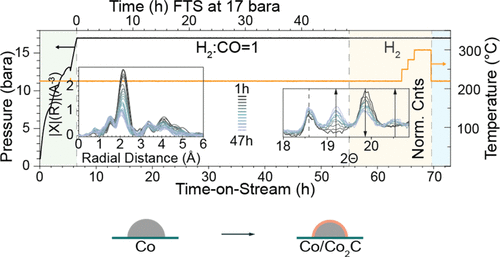当前位置:
X-MOL 学术
›
ACS Catal.
›
论文详情
Our official English website, www.x-mol.net, welcomes your feedback! (Note: you will need to create a separate account there.)
On the Cobalt Carbide Formation in a Co/TiO2 Fischer–Tropsch Synthesis Catalyst as Studied by High-Pressure, Long-Term Operando X-ray Absorption and Diffraction
ACS Catalysis ( IF 12.9 ) Pub Date : 2021-02-19 , DOI: 10.1021/acscatal.0c04695 Ilse K. van Ravenhorst 1 , Adam S. Hoffman 2 , Charlotte Vogt 1, 3, 4 , Alexey Boubnov 2 , Nirmalendu Patra 2 , Ramon Oord 1 , Cem Akatay 5 , Florian Meirer 1 , Simon R. Bare 2 , Bert M. Weckhuysen 1
ACS Catalysis ( IF 12.9 ) Pub Date : 2021-02-19 , DOI: 10.1021/acscatal.0c04695 Ilse K. van Ravenhorst 1 , Adam S. Hoffman 2 , Charlotte Vogt 1, 3, 4 , Alexey Boubnov 2 , Nirmalendu Patra 2 , Ramon Oord 1 , Cem Akatay 5 , Florian Meirer 1 , Simon R. Bare 2 , Bert M. Weckhuysen 1
Affiliation

|
Operando X-ray absorption spectroscopy (XAS) and X-ray diffraction (XRD) were performed on a Co/TiO2 Fischer–Tropsch synthesis (FTS) catalyst at 16 bar for (at least) 48 h time-on-stream in both a synchrotron facility and a laboratory-based X-ray diffractometer. Cobalt carbide formation was observed earlier during FTS with operando XAS than with XRD. This apparent discrepancy is due to the higher sensitivity of XAS to a short-range order. Interestingly, in both cases, the product formation does not noticeably change when cobalt carbide formation is detected. This suggests that cobalt carbide formation is not a major deactivation mechanism, as is often suggested for FTS. Moreover, no cobalt oxide formation was detected by XAS or XRD. In other words, one of the classical proposals invoked to explain Co/TiO2 catalyst deactivation could not be supported by our operando X-ray characterization data obtained at close to industrially relevant reaction conditions. Furthermore, a bimodal cobalt particle distribution was observed by high-angle annular dark-field scanning transmission electron microscopy and energy-dispersive X-ray analysis, while product formation remained relatively stable. The bimodal distribution is most probably due to the mobility and migration of the cobalt nanoparticles during FTS conditions.
中文翻译:

高压,长期操作X射线吸收和衍射研究Co / TiO 2费-托合成催化剂中碳化钴的形成
在16 bar的Co / TiO 2费-托合成(FTS)催化剂上进行Operando X射线吸收光谱(XAS)和X射线衍射(XRD),两者在(至少)运行时间中至少48小时同步加速器设施和基于实验室的X射线衍射仪。在FTS手术中观察到碳化钴的形成较早XAS比使用XRD更好。这种明显的差异是由于XAS对短程指令的敏感性更高。有趣的是,在两种情况下,当检测到碳化钴形成时,产物的形成都没有明显改变。这表明碳化钴的形成不是主要的失活机理,正如FTS经常提出的那样。而且,通过XAS或XRD未检测到氧化钴的形成。换句话说,我们的操作无法支持用来解释Co / TiO 2催化剂失活的经典提议之一。在接近工业上相关的反应条件下获得的X射线表征数据。此外,通过高角度环形暗场扫描透射电子显微镜和能量色散X射线分析观察到双峰钴颗粒分布,而产物形成保持相对稳定。双峰分布很可能是由于FTS条件下钴纳米颗粒的迁移和迁移所致。
更新日期:2021-03-05
中文翻译:

高压,长期操作X射线吸收和衍射研究Co / TiO 2费-托合成催化剂中碳化钴的形成
在16 bar的Co / TiO 2费-托合成(FTS)催化剂上进行Operando X射线吸收光谱(XAS)和X射线衍射(XRD),两者在(至少)运行时间中至少48小时同步加速器设施和基于实验室的X射线衍射仪。在FTS手术中观察到碳化钴的形成较早XAS比使用XRD更好。这种明显的差异是由于XAS对短程指令的敏感性更高。有趣的是,在两种情况下,当检测到碳化钴形成时,产物的形成都没有明显改变。这表明碳化钴的形成不是主要的失活机理,正如FTS经常提出的那样。而且,通过XAS或XRD未检测到氧化钴的形成。换句话说,我们的操作无法支持用来解释Co / TiO 2催化剂失活的经典提议之一。在接近工业上相关的反应条件下获得的X射线表征数据。此外,通过高角度环形暗场扫描透射电子显微镜和能量色散X射线分析观察到双峰钴颗粒分布,而产物形成保持相对稳定。双峰分布很可能是由于FTS条件下钴纳米颗粒的迁移和迁移所致。


























 京公网安备 11010802027423号
京公网安备 11010802027423号